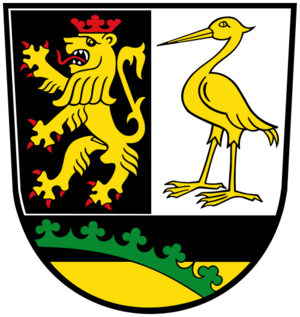Greiz Rural District facts for kids
Quick facts for kids
Landkreis Greiz
|
|
|---|---|
 |
|
| Country | |
| State | Thuringia |
| Capital | Greiz |
| Area | |
| • Total | 844 km2 (326 sq mi) |
| Population
(2002)
|
|
| • Total | 121,129 |
| • Density | 143.52/km2 (371.71/sq mi) |
| Time zone | UTC+1 (CET) |
| • Summer (DST) | UTC+2 (CEST) |
| Vehicle registration | GRZ |
| Website | http://www.landkreis-greiz.de |
Greiz is a rural district, also known as a Landkreis, located in the eastern part of Thuringia, Germany. It's a region with a rich history and many interesting places to explore.
Contents
A Look Back: History of Greiz
The area where Greiz is today was once part of a region called the Vogtland. This name came from the title Vogt, which was given to the local rulers way back in the 13th century. Imagine a time when powerful families ruled their own small areas!
Two important families from that time were the Reuß families. One of their main areas was in Greiz, and the other was in Gera and Schleiz. In 1919, these two areas joined together to form the Volksstaat Reuß, which means "People's State of Reuss". This new state then became part of Thuringia in 1920.
During World War II, a special work camp was located in Berga/Elster, within the district. People were made to dig tunnels and build railway tracks for a project called Schwalbe V.
The district of Greiz, as we know it today, was created on July 1, 1994. This happened when the older districts of Gera-Land, Zeulenroda, and the original Greiz district all joined together.
What Does the Greiz Coat of Arms Mean?
The coat of arms for the Greiz district tells a story about its past.
- The lion and the crane-bird you see at the top are symbols from the old Reuß families. They were part of their family crests and represented their power and history.
- At the bottom, you can see a part of the coat of arms of Saxony. This is because a small part of the Greiz district used to belong to the Duchies of Saxony, which were other important historical areas.
Towns and Villages in Greiz
The Greiz district is made up of many different towns and smaller communities. Here are some of the main ones:
| Verwaltungsgemeinschaft-free towns | and municipalities | |
|---|---|---|
|
|
|
Some of these towns and villages also work together in groups called Verwaltungsgemeinschaften (which means "administrative communities"). This helps them share resources and manage things more easily.
| Verwaltungsgemeinschaften | ||
|---|---|---|
|
1. Am Brahmetal
2. Auma-Weidatal
|
3. Ländereck
4. Leubatal
|
5. Münchenbernsdorf
|
| 1seat of the Verwaltungsgemeinschaft;2town | ||
Fun Places to Visit in Greiz
The Greiz district has many cool sights and historical places that you can visit.
Castles and Palaces
- The Upper Castle of Greiz
- The Lower Castle of Greiz
- The Summer Palace Greiz
- Weida Osterburg Castle
- Ronneburg Castle
- Reichenfels Castle Ruin (a castle that is now in ruins)
- Old Guardhouse "Alte Wache" in Greiz
Other Interesting Sights
- Zeulenroda Town Hall
- Widen Church Ruin in Weida (an old church that is now in ruins)
- St. Veit Parish Church
- Mildenfurth Monastery
- Cronschwitz Monastery Ruin (another monastery that is now in ruins)
- Greiz Park (a beautiful park to relax in)
- Fairy Tale Forest in Wünschendorf (a fun place with fairy tale themes)
Museums to Explore
If you like learning about history and culture, there are several museums in the Greiz district:
- Museum of Local History in Greiz
- Summer Palace in Greiz (this palace also has a museum inside!)
- Zeulenroda City Museum in Zeulenroda
- Osterburg Castle Museum in Weida, Thuringia (located inside the castle)
- Heinrich-Schütz-House in Bad Köstritz (dedicated to a famous German composer)
- Museum in Hohenleuben


